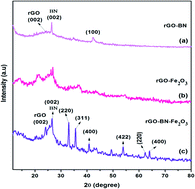当前位置:
X-MOL 学术
›
Sustain. Energy Fuels
›
论文详情
Our official English website, www.x-mol.net, welcomes your
feedback! (Note: you will need to create a separate account there.)
Enhanced cathode performance of Fe2O3, boron nitride-doped rGO nanosheets for microbial fuel cell applications
Sustainable Energy & Fuels ( IF 5.0 ) Pub Date : 2020/01/08 , DOI: 10.1039/c9se01243e Shanmugam Mahalingam 1, 2, 3, 4 , Sivasankaran Ayyaru 1, 2, 3, 4 , Young-Ho Ahn 1, 2, 3, 4
Sustainable Energy & Fuels ( IF 5.0 ) Pub Date : 2020/01/08 , DOI: 10.1039/c9se01243e Shanmugam Mahalingam 1, 2, 3, 4 , Sivasankaran Ayyaru 1, 2, 3, 4 , Young-Ho Ahn 1, 2, 3, 4
Affiliation

|
Iron(III) oxide (Fe2O3) and boron nitride (BN)-doped reduced graphene oxide (rGO) nanosheets were prepared successfully using a surfactant-free hydrothermal method. Through this method, one-dimensional Fe2O3 nanorods and boron nitride were incorporated into rGO nanosheets. The hybrid nanocomposite (rGO–BN–Fe2O3) was analyzed by X-ray diffraction, field emission scanning electron microscopy, high-resolution transmission electron microscopy (HR-TEM) with selected area electron diffraction, and X-ray photoelectron spectroscopy. HR-TEM revealed the Fe2O3 nanorods to have a mean size of 20–30 nm with a uniform distribution distributed over the rGO nanosheets. In this study, the performance of the graphene-based hybrid nanocomposites, rGO–BN–Fe2O3, was assessed using novel cathode catalysts in a single-chamber-air-cathode microbial fuel cell (MFC). MFCs with different catalyst loadings (single layer (SL), double layer (DL), and triple layer (TL)) were fabricated. The electrochemical performance of the MFCs was analyzed by cyclic voltammetry and impedance analysis. The MFCs with the rGO–BN–Fe2O3 hybrid nanocomposite cathode showed higher maximum power densities (81%) than those with the rGO–BN and rGO–Fe2O3 composites. The MFCs with a cathode containing a DL loading of the rGO–BN–Fe2O3 hybrid nanocomposite showed a high power generation of 1673 ± 11 mW m−2 and an OCP of 663 ± 4 mV compared to that generated with the other MFC-SL and MFC-TL loadings, respectively. The double-loaded cathode rGO–BN–Fe2O3 hybrid nanocomposite MFCs produced 81% of the predicted power density for Pt/C MFCs, 2066 ± 15 mW m−2. Therefore, the considerable increases in power density highlight the potential of the rGO–BN–Fe2O3 hybrid nanocomposite cathode as a material for MFC applications. The double loaded catalyst of the rGO–BN–Fe2O3 hybrid nanocomposite cathode, is a promising, less expensive green material for constant power generation and prolonged operation of MFCs compared to the platinum on carbon (Pt/C) electrode.
中文翻译:

Fe2O3,掺氮化硼的rGO纳米片的阴极性能增强,可用于微生物燃料电池
铁(III)氧化物(FE 2 ö 3)和氮化硼(BN)掺杂的还原的石墨烯氧化物(RGO)纳米片,使用一个无表面活性剂的水热方法成功地制备。通过这种方法,将一维Fe 2 O 3纳米棒和氮化硼掺入到rGO纳米片中。通过X射线衍射,场发射扫描电子显微镜,选择区域电子衍射的高分辨率透射电子显微镜(HR-TEM)和X射线光电子能谱分析了杂化纳米复合材料(rGO–BN–Fe 2 O 3)。 。HR-TEM揭示了Fe 2 O 3纳米棒的平均大小为20–30 nm,并且在rGO纳米片上分布均匀。在这项研究中,使用新型阴极催化剂在单室空气阴极微生物燃料电池(MFC)中评估了石墨烯基杂化纳米复合材料rGO–BN–Fe 2 O 3的性能。制备了具有不同催化剂负载量(单层(SL),双层(DL)和三层(TL))的MFC。通过循环伏安法和阻抗分析来分析MFC的电化学性能。具有rGO–BN–Fe 2 O 3杂化纳米复合阴极的MFC显示出比具有rGO–BN和rGO–Fe 2 O 3的MFC更高的最大功率密度(81%)复合材料。与其他MFC相比,具有d负载rGO–BN–Fe 2 O 3杂化纳米复合材料的DL负载的MFC显示出1673±11 mW m -2的高发电量和663±4 mV的OCP。 -SL和MFC-TL加载。双负载阴极rGO–BN–Fe 2 O 3杂化纳米复合MFC产生的Pt / C MFC的预测功率密度为2066±15 mW m -2的81%。因此,功率密度的显着提高突出了rGO-BN-Fe 2 O 3杂化纳米复合阴极作为MFC应用材料的潜力。rGO–BN–Fe 2 O的双负载催化剂与碳铂(Pt / C)电极相比, 3杂化纳米复合阴极是一种有前途,更便宜的绿色材料,可实现恒定的发电和MFCs的长时间运行。
更新日期:2020-03-03
中文翻译:

Fe2O3,掺氮化硼的rGO纳米片的阴极性能增强,可用于微生物燃料电池
铁(III)氧化物(FE 2 ö 3)和氮化硼(BN)掺杂的还原的石墨烯氧化物(RGO)纳米片,使用一个无表面活性剂的水热方法成功地制备。通过这种方法,将一维Fe 2 O 3纳米棒和氮化硼掺入到rGO纳米片中。通过X射线衍射,场发射扫描电子显微镜,选择区域电子衍射的高分辨率透射电子显微镜(HR-TEM)和X射线光电子能谱分析了杂化纳米复合材料(rGO–BN–Fe 2 O 3)。 。HR-TEM揭示了Fe 2 O 3纳米棒的平均大小为20–30 nm,并且在rGO纳米片上分布均匀。在这项研究中,使用新型阴极催化剂在单室空气阴极微生物燃料电池(MFC)中评估了石墨烯基杂化纳米复合材料rGO–BN–Fe 2 O 3的性能。制备了具有不同催化剂负载量(单层(SL),双层(DL)和三层(TL))的MFC。通过循环伏安法和阻抗分析来分析MFC的电化学性能。具有rGO–BN–Fe 2 O 3杂化纳米复合阴极的MFC显示出比具有rGO–BN和rGO–Fe 2 O 3的MFC更高的最大功率密度(81%)复合材料。与其他MFC相比,具有d负载rGO–BN–Fe 2 O 3杂化纳米复合材料的DL负载的MFC显示出1673±11 mW m -2的高发电量和663±4 mV的OCP。 -SL和MFC-TL加载。双负载阴极rGO–BN–Fe 2 O 3杂化纳米复合MFC产生的Pt / C MFC的预测功率密度为2066±15 mW m -2的81%。因此,功率密度的显着提高突出了rGO-BN-Fe 2 O 3杂化纳米复合阴极作为MFC应用材料的潜力。rGO–BN–Fe 2 O的双负载催化剂与碳铂(Pt / C)电极相比, 3杂化纳米复合阴极是一种有前途,更便宜的绿色材料,可实现恒定的发电和MFCs的长时间运行。











































 京公网安备 11010802027423号
京公网安备 11010802027423号